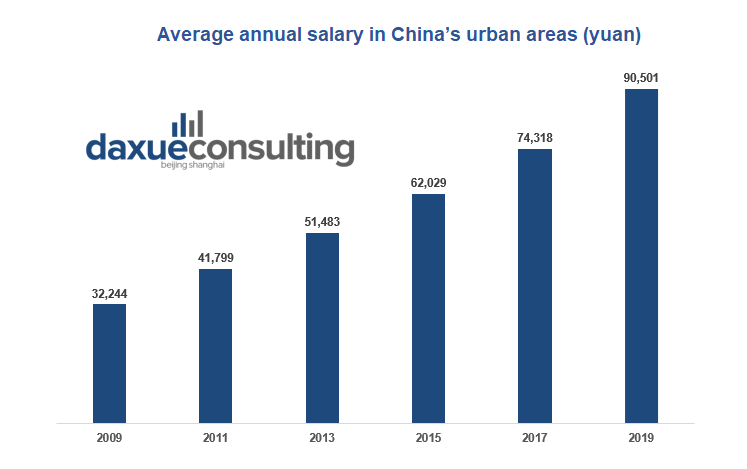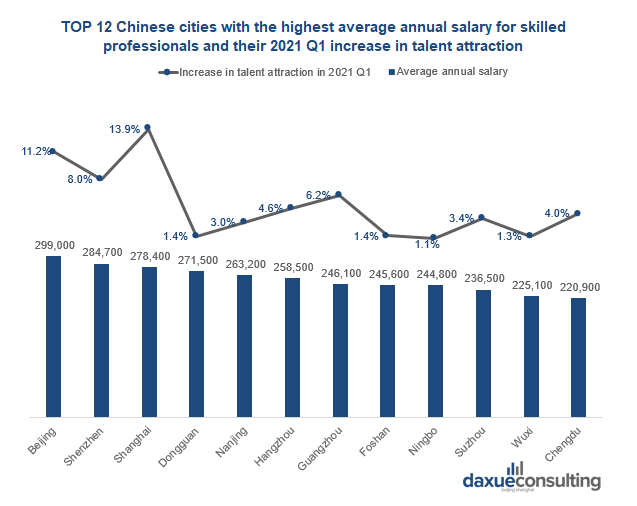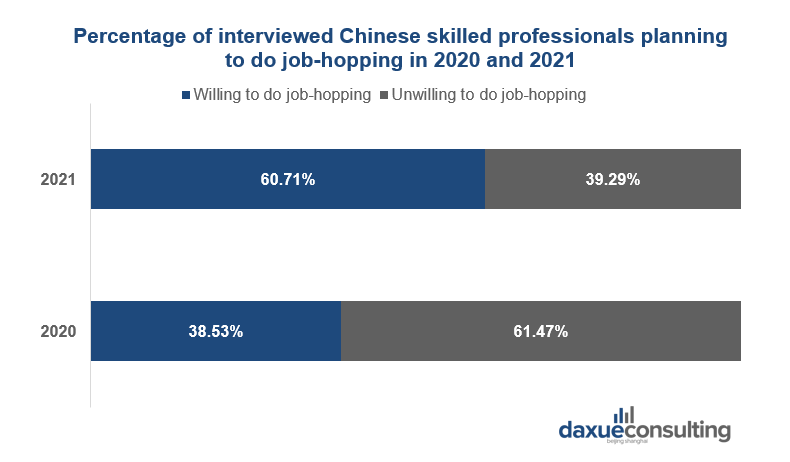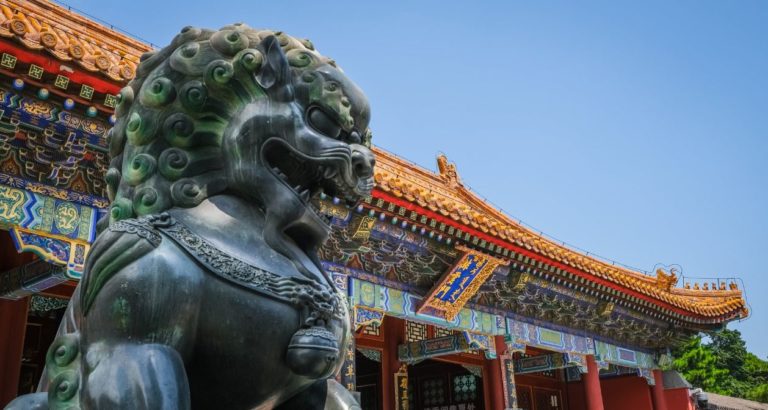With the end of the Covid-19 pandemic and the rapid recovery of the national economy, the job market for medium and highly skilled professionals in China started to thrive again, raising hopes for an increasingly brighter future. During 2021 Q1, the number of new jobs experienced a 99.02% year-on-year increase and the average annual salary for mid-high skilled professionals in China hit 207,600 RMB. According to Liepin, 80.75% of enterprises are confident about the positive trend of 2021 spring recruitment season and are convinced that higher salaries are going to attract better candidates. Job seekers feel enthusiastic about the current trend of the labor market as well.
How China’s labor market has evolved in recent years
As the country continues its’ development, China’s professional landscape is progressively moving towards the services industry which took about 33% share of the workforce in 2009 but makes up around 50% today. More importantly, the ever-increasing standards of living in China accompanying the Chinese economic boom have led to both higher average wages and higher postgraduate education. If some leading industries could struggle to find skilled talents to hire domestically in the past, the Chinese labor force has since evolved to meet the demand. Now that the job market for skilled professionals in China has expended, it got more competitive, with notably higher expectations toward compensation and employee benefits. High-tech industry sectors are particularly attractive to these new skilled Chinese workers despite the notoriously long working hours that are common practice in this environment.

A more in-depth look at the skilled labor market in China
The six sectors boasting the largest demand of medium and highly skilled workers are those related to New Energy Vehicles (NEV), tourism, entertainment, pharmaceutical and healthcare, new consumer goods and digital economy. Among them, tourism, NEV and healthcare are the sectors experiencing the fastest growth, vaunting an extraordinary year-on-year increase of 109.83%, 103.53% and 80.89% respectively. Instead, compared to 2019 Q1, new consumer goods, digital economy and healthcare had the most significant rise.
Jobs dealing with digital economy are those offering the highest salaries, followed by those in new consumer goods and NEV. In such three sectors, skilled professionals in China can earn up to 231,700 RMB, 196,600 RMB and 189,500 RMB per year on average. Not surprisingly, most of job-hoppers declare that they would like to work in one of the aforementioned fields.
Analyzing more closely the data from Liepin’s report, during 2021 Q1 the Internet/ mobile internet/ e-commerce sector was mid-high skilled workers’ favorite industry, absorbing 11.51% of the total amount of such job seekers and providing a relatively high average annual salary of 282,600 RMB. The construction sector is recovering very quickly from the sharp fall suffered during the pandemic and it currently ranks fourth in terms of largest average annual pay.

A place under the sun: skilled professionals’ main destinations
During 2021 Q1, Shanghai and Beijing boasted the largest share of mid-high skilled workers, attracting respectively 13.89% and 11.24% of talents. Shenzhen, Guangzhou, Hangzhou, Chengdu rank in talents’ TOP 6 main destinations, accounting for between 8% and 4% of skilled job seekers.
Regarding instead their average annual salary, the five cities providing the highest wages are Beijing, Shenzhen, Shanghai, Dongguan and Nanjing, where medium and highly skilled professionals can aspire to earn above 260,000 RMB per year. The rise of Dongguan should not go unnoticed. The Cantonese city shifted from being a leading export and manufacturing hub for low-value added goods to become a core high-tech industrial base: it is estimated that one in five smartphones in the world are made in Dongguan and even the telecommunication giant Huawei decided to locate its R&D headquarters there. In 2020, the former low-end manufacturing hub ranked 24th among the TOP 100 richest cities in China, with a GDP almost reaching one trillion RMB. Therefore, it is not surprising that more and more skilled job seekers opt for moving to work in Dongguan, turning it into one of their main destinations.
Despite not appearing at the top of mid-high skilled professionals’ favorite cities, Haikou is moving upwards at a steady pace, as a result of the establishment of Hainan Free Trade Zone last year. Indeed, in the last three years, the tropical city attracted about 23,300 skilled talents coming from mainland China, marking a 675% increase.

Job-hopping in China: a contented mind may not be a perpetual feast
As the Chinese economy recovers from the consequences of a global pandemic and confidence in the domestic market grows, job-hopping becomes more widespread: the amount of skilled professionals in China planning to change their work in 2021 almost doubled compared to 2020. “Getting a better pay”, “looking for professional development” and “Circumventing major obstacles in their current career” are the main drivers pushing mid-high skilled workers to practice job-hopping. More specifically, wages and welfare benefits are the most important factors when deciding to apply for a new job.
Chinese job-hoppers tend to have realistic goals: almost half of them look for a 20%-30% salary rise and 38.1% of those who have already started a new position in 2021 Q1 managed to get such bump in pay. Skilled professionals who have already changed their job account for around 20% of the total and above 90% of them feel satisfied with their new position. Instead, 54.49% of Chinese job-hoppers has received between one and three new offers, while 38.08% of them is still waiting for their first job offer.

What 2021 Q1 job posting data says about China’s economic recovery
- As China’s economy recovers from the effects of the Covid-19 pandemic, data from 2021 Q1 spring recruitment season depicts a job market full of new opportunities. Both enterprises and job seekers are confident about the current trend of the labour market.
- Tourism, NEV and healthcare are experiencing the fastest year-on-year increase, but compared to 2019 Q1, new consumer goods, digital economy and healthcare are boasting the most significant rise.
- Internet-related industries attract the largest number of skilled professionals in China and provide a higher than average annual salary of 282,600 RMB.
- Skilled talents’ main destinations are Shanghai, Beijing, Shenzhen, Guangzhou, Hangzhou, and Chengdu, while in Beijing, Shenzhen, Shanghai, Dongguan and Nanjing medium and highly skilled professionals can aspire to the highest salaries.
- Although Haikou is not among mid-high skilled professionals’ favorite cities, it is moving upwards very fast, recording a 675% rise in attracted talents in the last three years.
- The economic recovery pushed many people to change their job in search for higher pay and more generous welfare benefits. Chinese job-hoppers usually do not aim too high and easily get what they are looking for. Indeed, 90% of those who have already found a new job are satisfied with their current position.





